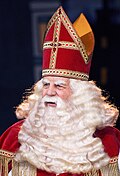Dutch Americans
Dutch Americans (Dutch: Nederlandse Amerikanen), not to be confused with the Pennsylvania Dutch, are Americans of Dutch descent whose ancestors came from the Netherlands. Dutch settlement in the Americas started in 1613 with New Amsterdam, which was exchanged with the English for Suriname at the Treaty of Breda (1667) and renamed to New York City. The English split the Dutch colony of New Netherland into two pieces, and named them New York and New Jersey. More immigration occurred in the 19th and 20th centuries.
 | |
| Total population | |
|---|---|
| 4,533,617[1] 1.43% of the U.S. population (2013) | |
| Regions with significant populations | |
| West Coast especially in California, Mountain states especially in Montana, Wyoming, and Colorado, Northeast especially in Pennsylvania, New York, and New Jersey, Midwest especially in Iowa, Michigan, Indiana, Ohio, Wisconsin, Minnesota, Missouri, Illinois, Nebraska, Kansas, and the Dakotas | |
| Languages | |
| English, Dutch | |
| Religion | |
| 74% Protestant; 10% Roman Catholic, 15% other[2] | |
| Related ethnic groups | |
| Dutch people, Dutch Brazilians, Dutch Canadians, Dutch Surinamese, Afrikaners, Pennsylvania Dutch, Belgian Americans |
Dutch Americans Media
Principal Dutch colonies in North America
Flag of the Dutch Colony of New Netherland (now encompassing parts of what are now New York, New Jersey, and Delaware.)
Typical Dutch homestead in Northeast Wisconsin, circa 1855
Martin Van Buren circa 1855. He was the first U.S. President without any British ancestry as he was of entire Dutch descent.
References
- ↑ Data Access and Dissemination Systems (DADS). "American FactFinder - Results". census.gov. Archived from the original on 2017-05-25. Retrieved 2021-01-01.
- ↑ One Nation Under God: Religion in Contemporary American Society, p. 120






